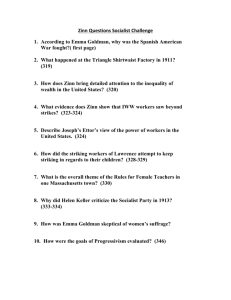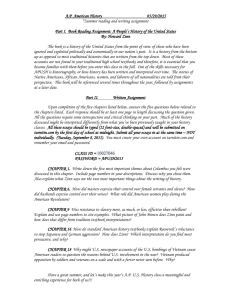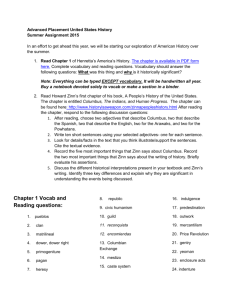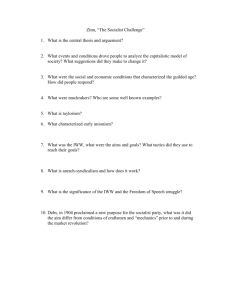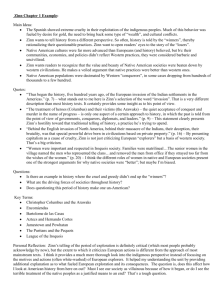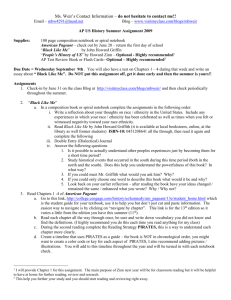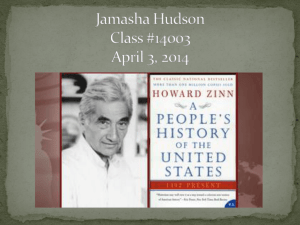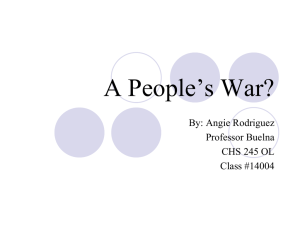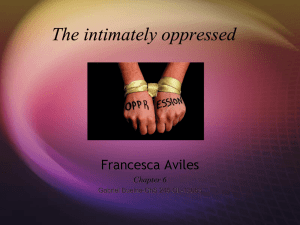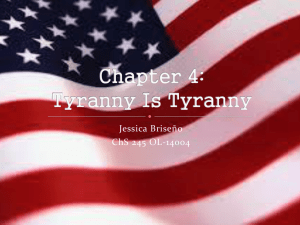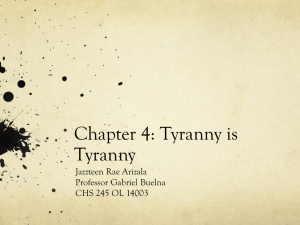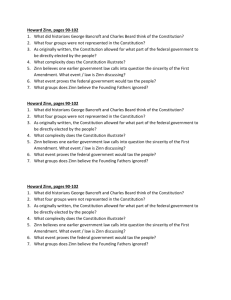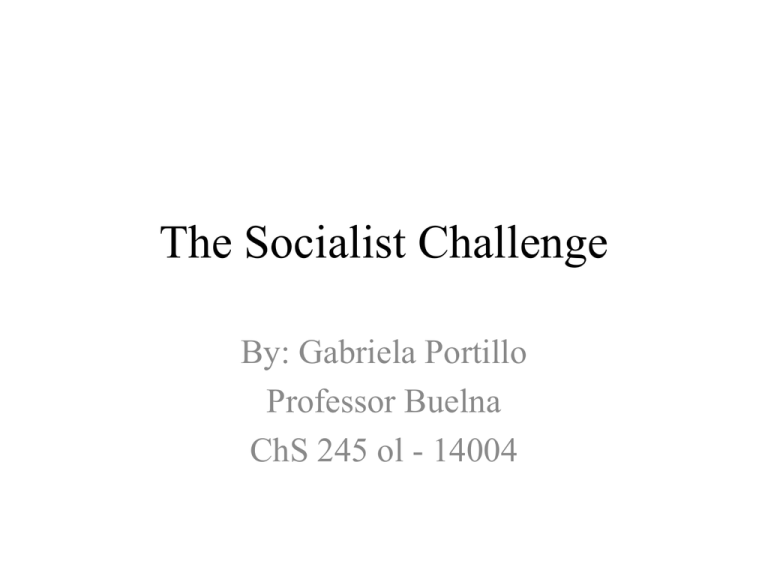
The Socialist Challenge
By: Gabriela Portillo
Professor Buelna
ChS 245 ol - 14004
•
“There were writers of the early twentieth century who spoke for socialism or
criticized the capitalist system harshly- not obscure pamphleteers, but among the
most famous of American literary figures, whose books were read by millions:
Upton Sinclair, Jack London, Theodore Dreiser, Frank Norris.”(Zinn 322).
Upton Sinclair
•
•
•
•
His novel The Jungle exposed conditions in Chicago meatpacking plants
This made people demand laws which would enforce and help maintain the meat industry
His novel also brought about issues of socialism by integrating a story of an immigrant laborer by the name
of Jurgis Rudkus
His influence for this book came by Jack London’s book People of the Abyss
Jack London
•Jack London was part of the Socialist party
•Wrote a novel called The Iron Heel , where he warned that America would become a fascist country
•He wrote “In the face of the facts that modern man lives more wretchedly than the cave man, and
that his producing power is a thousand times greater than that of the cave man, no other conclusion
is possible than that the capitalist class has mismanaged… criminally and selfishly
mismanaged”(Zinn 322).
•
•
•
•
•
“By 1900 , neither the patriotism of the war nor the absorption of energy in
elections could disguise the troubles of the system. The process of business
concentration had gone forward; the control by bankers had become more clear. As
technology developed and corporations became larger, they needed more capital,
and it was the bankers who had this capital”(Zinn 323).
There were already more than a thousand railroads that were affiliated with
Morgan or Rockefeller interests by 1904.
“The imperial leader of the new oligarchy was the House of Morgan. In its
operations it was able assisted by the First National Bank of New York(directed by
GeorgeF. Baker) and the National City Bank of New York (presided over by James
Stillman, agent of the Rockefeller interests). Among them, these three men and
their financial associates occupied 341 directorships in 112 great corporations. The
total resources of these corporations in 1912 was $22,245,000,000, more than the
assessed value of all property in the twenty-two states and territories west of the
Mississippi River.”(Zinn 323).
In 1907, profits that the capitalist wanted were not as high due to a crisis that
happened, where big businesses were not hurt but the industry wasn’t growing as
big and fast as they wanted.
This meant that industrialists had to cut costs however they could.
•
•
•
•
•
•
•
One idea that they tried to implement was Taylorism
TAYLORISM: is the belief that everyone has free will
“The purpose of Taylorism was to make workers interchangeable, able to do the
simple tasks that the new division of labor required- like standard parts divested of
individuality and humanity, bought and sold as commodities”(Zinn 324).
This new system worked well with the automobile industry
“In 1909, Ford sold 10, 607 autos; in 1913, 168,000; in 1914, 248,000. The profit
was $30 million”(Zinn 324).
Taylorism also became more effective because of the amount of unskilled jobs and
workers, many of who were immigrants and who were also willing to work under
any circumstances as long as they were able to be able to provide food for their
families
In New York City, the new immigrants went to work in the sweatshops
“In unaired rooms, mothers and fathers sew by day and by night. Those in the home
sweatshop must work cheaper than those in the factory sweatshops… And the
children are called in from play to drive and drudge beside their elders…”(Zinn
324).
Sadly, sweatshops still exist today
and many of the brands that we wear
like Nike, Old Navy, and JC Penny,
still use sweatshops and most of us
aren’t aware of it.
•
•
•
There were many strikes that followed after workers united to fight for better
working conditions and higher pay. Many women, men , and children were part of
these strikes and although they started striking, they never knew that the road for
equality, would be a difficult and brutal one.
One of these strikers was a woman by the name of Pauline Newman who describes
a strike she was a part of:
“Thousands upon thousands left the factories from every side, all of them walking
down toward Union Square. It was November, the cold winter was just around the
corner, we had no fur coats to keep warm, and yet there was the spirit that led us on
and on until we got to some hall. I can see the young people, mostly women,
walking down and not caring what might happen… the hunger, cold, loneliness…
They just didn’t care on that particular day; that was their day”(Zinn 325).
This comes to show that although they kept in minds that they might lose their jobs,
they went without fear, showing courage that no matter what, they were going to
fight for what they believed in.
•
•
•
•
•
Many workers would strike out everyday and many women in particular , would
join the International Ladies Garment Workers Union
Women of color also were part of strikes and made up the labor unions as well
Women also tried everything they could to empower themselves and support each
other
Pauline Newman states ,“We tried to educate ourselves . I would invite girls to my
rooms, and we took turns reading poetry in English to improve our understanding
of the language. One of our favorites was Thomas Hood’s “Song of the Shirt,” and
another… Percy Bysshe Shelley’s “Mask of Anarchy”(Zinn 326).
Women were showing that they didn’t need to be dependent on anybody and that
with each of them supporting each other, they would be able to progress and
become more able to communicate what it was that they wanted
•
•
•
•
•
Aside from working under terrible working conditions, workers also worked in
work places where the buildings were not up to code, and were therefore dangerous
to be in
There was a fire on March 25, 1911, where rag burned and engulfed the eighth,
ninth, and tenth floors in flames
There were about 500,000 workers were burned and died since the firefighters’
ladders could only reach up to the seventh floor
“The laws said factory doors had to open outward. But at the Triangle Company the
doors opened in. The law said the doors could not be locked during working hours,
but at the Triangle Company doors were usually locked so the company could keep
track of the employees. And so, trapped, the young women were burned to death at
their work-tables, or jammed against the locked exit door, or leaped to their deaths
down the elevator shafts”(Zinn 326).
35,000 workers were killed in industrial accidents and 700,000 were injured
according to a report of the Commission on Industrial Relations
Triangle Shirtwaist Company fire March 25, 1911
•
•
•
•
•
Unions were strongly growing and the members of the unions soon were growing
with more men, and people of color integrating
The IWW ( Industrial Workers of the World) was formed which aimed at organizing
all workers in any industry into “One Big Union,” undivided by sex, race, or skills.”
People in this organization were vey brave and didn’t believe that violence would
solve anything but if they were attacked, they wouldn’t back down from a fight.
The IWW eventually became a threat to the capitalist class
Authorities even implemented laws to keep them from speaking and they didn’t
obey the laws
•
Finally, after much striking and speaking out on issues that they wanted to be fixed,
workers were offered raises of as much as 5-11 percent, time and quarter for
overtime, and no discrimination against those who had struck. Their raises were
given by the American Woolen Company.
The road to being able too get higher pay for the labor that workers were doing, was a
very long one, but eventually after being motivated and not giving up, they were
able to demonstrate that no matter what, they were not going to give up.
Reference Page
Zinn, Howard. A People’s History of the United States. Harper Collins Publishers,
1999. Print.

